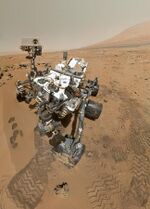Astronomy:Kepler-32
| Observation data Equinox J2000.0]] (ICRS) | |
|---|---|
| Constellation | Cygnus |
| Right ascension | 19h 51m 22.1742s[1] |
| Declination | +46° 34′ 27.390″[1] |
| Apparent magnitude (V) | 16.0[2] |
| Characteristics | |
| Spectral type | M1V[3] |
| Astrometry | |
| Proper motion (μ) | RA: −13.618±0.058[1] mas/yr Dec.: 19.646±0.068[1] mas/yr |
| Parallax (π) | 3.0595 ± 0.0322[1] mas |
| Distance | 1,070 ± 10 ly (327 ± 3 pc) |
| Details | |
| Mass | 0.58±0.05[2] M☉ |
| Radius | 0.53±0.04[2] R☉ |
| Surface gravity (log g) | 4.64[3] cgs |
| Temperature | 3900±200[2] K |
| Metallicity [Fe/H] | 0.00 dex |
| Rotation | 36.220±0.256 days[4] |
| Other designations | |
| Database references | |
| SIMBAD | data |
| KIC | data |
Kepler-32 is an M-type main sequence star located about 1070 light years from Earth, in the constellation of Cygnus. Discovered in January 2012 by the Kepler spacecraft,[5] it shows a 0.58 ± 0.05 solar mass (M☉), a 0.53 ± 0.04 solar radius (R☉), and temperature of 3900.0 K, making it half the mass and radius of the Sun, two-thirds its temperature and 5% its luminosity.[6]
Planetary system
In 2011, 2 planets orbiting around it, were discovered, and two more suspected.[7] The smaller Kepler-32b, orbiting its parent star every 5.90124 days, and Kepler-32c with an orbital period of 8.7522 days.[8] In April 2013, transit-timing variation analysis confirmed 3 other planets to be in the system. However, only very loose constraints of the maximum mass of the planets could be determined.[9] In 2014, the dynamical simulation shown what the Kepler-32 planetary system have likely undergone a substantial inward migration in the past, producing an observed pattern of lower-mass planets on tightest orbits.[10] Additional yet unobserved gas giant planets on wider orbit are likely necessary for migration of smaller planets to proceed that far inward,[11] although current planetary systems would be unstable if additional planets are located closer than 8.7 AU from the parent star.[12]
| Companion (in order from star) |
Mass | Semimajor axis (AU) |
Orbital period (days) |
Eccentricity | Inclination | Radius |
|---|---|---|---|---|---|---|
| f | — | 0.013 | 0.742956 | — | — | 0.81±0.05 R⊕ |
| e | — | 0.033 | 2.896009 | — | — | 1.5±0.1 R⊕ |
| b | 0.011[14] MJ | 0.05 | 5.90124 | — | — | 2.2±0.2 R⊕ |
| c | 0.012[14] MJ | 0.09 | 8.7522 | — | — | 2.0±0.2 R⊕ |
| d | — | 0.129 | 22.780806 | — | — | 2.7±0.1 R⊕ |
References
- ↑ Jump up to: 1.0 1.1 1.2 1.3 1.4 Brown, A. G. A. (August 2018). "Gaia Data Release 2: Summary of the contents and survey properties". Astronomy & Astrophysics 616: A1. doi:10.1051/0004-6361/201833051. Bibcode: 2018A&A...616A...1G. Gaia DR2 record for this source at VizieR.
- ↑ Jump up to: 2.0 2.1 2.2 2.3 "Notes on Kepler-32 b". Extrasolar Planets Encyclopaedia. https://exoplanet.eu/catalog/kepler_32_b--1069/.
- ↑ Jump up to: 3.0 3.1 3.2 "KOI-952". SIMBAD. Centre de données astronomiques de Strasbourg. http://simbad.u-strasbg.fr/simbad/sim-basic?Ident=KOI-952.
- ↑ McQuillan, A.; Mazeh, T.; Aigrain, S. (2013). "Stellar Rotation Periods of The Kepler objects of Interest: A Dearth of Close-In Planets Around Fast Rotators". The Astrophysical Journal Letters 775 (1): L11. doi:10.1088/2041-8205/775/1/L11. Bibcode: 2013ApJ...775L..11M.
- ↑ NBC. "100 billion alien planets fill our galaxy: study". NBC News. http://www.nbcnews.com/id/50348563/ns/technology_and_science-space/#.US-dW4Z8wVB.
- ↑ Swift, Jonathan J. (2012). "Characterizing the Cool KOIs IV: Kepler-32 as a prototype for the formation of compact planetary systems throughout the Galaxy". The Astrophysical Journal 764 (1): 105. doi:10.1088/0004-637X/764/1/105. Bibcode: 2013ApJ...764..105S.
- ↑ Lissauer, Jack J.; Ragozzine, Darin; Fabrycky, Daniel C.; Steffen, Jason H.; Ford, Eric B.; Jenkins, Jon M.; Shporer, Avi; Holman, Matthew J. et al. (2011), "Architecture and Dynamics of Kepler 'S Candidate Multiple Transiting Planet Systems", The Astrophysical Journal Supplement Series 197 (1): 8, doi:10.1088/0067-0049/197/1/8, Bibcode: 2011ApJS..197....8L
- ↑ The Extrasolar Planet Encyclopedia. "Kepler-32". Exoplanet.eu. http://voparis-exoplanet-new.obspm.fr/catalog/?f=%27Kepler-32%27+in+name.
- ↑ Fabrycky, Daniel C. (2012). "Transit Timing Observations from Kepler: IV. Confirmation of 4 Multiple Planet Systems by Simple Physical Models". The Astrophysical Journal 750 (2): 114. doi:10.1088/0004-637X/750/2/114. Bibcode: 2012ApJ...750..114F.
- ↑ T. O. Hands, R. D. Alexander, W. Dehnen, "Understanding the assembly of Kepler's compact planetary systems", 2014
- ↑ Hands, T. O.; Alexander, R. D. (2015), "There might be giants: unseen Jupiter-mass planets as sculptors of tightly-packed planetary systems", Monthly Notices of the Royal Astronomical Society 456 (4): 4121–4127, doi:10.1093/mnras/stv2897, Bibcode: 2016MNRAS.456.4121H
- ↑ Becker, Juliette C.; Adams, Fred C. (2017), "Effects of Unseen Additional Planetary Perturbers on Compact Extrasolar Planetary Systems", Monthly Notices of the Royal Astronomical Society 468 (1): 549–563, doi:10.1093/mnras/stx461, Bibcode: 2017MNRAS.468..549B
- ↑ NASA Exoplanet Archive--Planet Host Overview page:Kepler-32
- ↑ Jump up to: 14.0 14.1 Characterizing the Cool KOIs. IV. Kepler-32 as a Prototype for the Formation of Compact Planetary Systems throughout the Galaxy
Coordinates: ![]() 19h 51m 22s, +46° 34′ 27″
19h 51m 22s, +46° 34′ 27″
 |



